Use 'Print preview' to check the number of pages and printer settings.
Print functionality varies between browsers.
Printable page generated Friday, 10 May 2024, 9:55 PM
Study Session 6 Components of the OWNP
Introduction
The principles and pillars of the OWNP that you have learned about in previous study sessions provide the basis and foundation for the Programme. In this study session you will learn that the resources for the Programme are divided into four major components. You will look into the details of each of the components so that you can appreciate their similarities as well as their differences. You will also study how the components are tailored to be implemented separately but share a common objective: to improve the WASH provisions at all levels across the nation.
This study session describes the four major components. The ways in which approaches to implementing the Programme vary between these components is the topic of Study Session 10.
Learning Outcomes for Study Session 6
When you have studied this session, you should be able to:
6.1 Define and use correctly all of the key words printed in bold. (SAQ 6.1)
6.2 Outline the four components of OWNP and identify their key features. (SAQ 6.2)
6.3 Describe the WASH settings covered by the programme components, i.e. rural, pastoral, urban and institutional WASH. (SAQs 6.3, 6.4 and 6.5)
6.4 Outline programme management and capacity building in the context of the OWNP. (SAQ 6.6)
6.1 Introduction to the OWNP components
The OWNP has ambitious targets to increase the national safe water supply coverage to 98.5%, sanitation (latrine use) coverage to 100%, and meet all other WASH-related targets. To achieve these goals, resources have to be allocated strategically to meet the required improvements for all Ethiopians. Based on this consideration, the OWNP has been divided into four major components:
- Rural and pastoral WASH
- Urban WASH
- Institutional WASH
- Programme management and capacity building.
Components, in the OWNP context, are categories that divide the programme into appropriate sub-sections according to physical and financial planning needs, implementation, and monitoring and evaluation activities. The first three components cover the provision of WASH services in each of the named settings. The fourth component, programme management and capacity building, is a cross-cutting intervention that aims to reinforce and facilitate implementation of plans in the first three components.
The first three components are further divided into sub-components by sector as follows:
Component 1: Rural and pastoral WASH
- Rural water supply
- Rural sanitation and hygiene promotion
- Pastoral water supply
- Pastoral sanitation and hygiene promotion.
Component 2: Urban WASH
- Urban water supply
- Urban sanitation and hygiene promotion.
Component 3: Institutional WASH
- Institutional water supply
- Institutional sanitation and hygiene promotion.
Each of the components has its own individual features. These relate to the characteristics of the beneficiaries, the environmental setting the people are living in, available infrastructure and capacities, and the partners or stakeholders concerned with promotion of WASH. These differences mean that each component requires an approach or mechanism particularly tailored to those circumstances.
Note that rural and pastoral WASH are grouped together as a single component, but for this study session they will be discussed separately. This is because, even though they can be categorised as one component using a simple rural-urban perspective, there are many attributes that make rural WASH and pastoral WASH quite different. There are differences in life style, livelihood, and traditions, as well as geographic and environmental characteristics that have implications for WASH promotion in these two settings.
In an Ethiopian context and in other less developed countries, rural refers to areas where homes are dispersed or people live in small settlements of less than 10,000 inhabitants. In rural areas, almost all inhabitants base their livelihood on agricultural activities. Typically, infrastructure such as roads, electric supply, water and sanitation, banking, telecommunication, transportation and other services are either non-existent or underdeveloped. Urban refers to towns and cities with larger population and relatively better socio-economic infrastructure and service provision. Semi-urban or peri-urban refers to human settlement areas that are between rural and urban settlements and share features of both. (Note that semi- means half, as in semi-circle. Peri- means around, as in perimeter.) This categorisation of human settlements in terms of rural or urban is based mainly on three important features: population size (number of inhabitants), socio-economic infrastructure and type of livelihood.
The following sections discuss the four components in more detail.
6.2 Rural WASH
In common with other developing countries, the majority of Ethiopian people live in rural areas where the social and economic infrastructures and services are less developed. According to the JMP (2014a), 82% of the Ethiopian population, more than 81 million people, reside in rural areas. The required effort to address the demand for water and sanitation for this many people is huge but, if successful, can significantly change the overall picture in terms of WASH services in Ethiopia.
In past decades, the Ethiopian government followed a development direction for WASH and other services that focused on rural areas, and this has brought encouraging results. Using these past experiences and lessons learned to capitalise on previous results, the OWNP includes rural WASH as one of the core components. Moreover, the OWNP will be implemented in all regions and districts, which should resolve disparities in rural WASH service coverage that have existed in the past.
6.2.1 Rural water supply
Based on the Ethiopian Water Resources Management Policy (WRMP) of 1999 (which you read about in Study Session 2), the rural water supply sub-component of the OWNP emphasises decentralised management as well as integrated and participatory approaches to implementation. The WRMP also specified that rural water supply schemes should ensure the recovery of operation and maintenance costs. (Operation and maintenance or O&M, refers to all the activities required to keep a service functional. O&M costs are the running costs that will continue over time, as opposed to capital costs which refer to the initial costs of installing a new service. Recovery of O&M costs means that users of a service should pay enough money to cover all the running costs through a consented water tariff system. Water tariff is the price paid by consumers for water.)
In Ethiopia, sustaining water supply services over time is a major challenge. In many cases, after a short period of service, schemes fail due to technical faults and lack of maintenance (Figure 6.1). Studies have shown that about 30% of water supply schemes are non-functional, mostly because of minor problems.
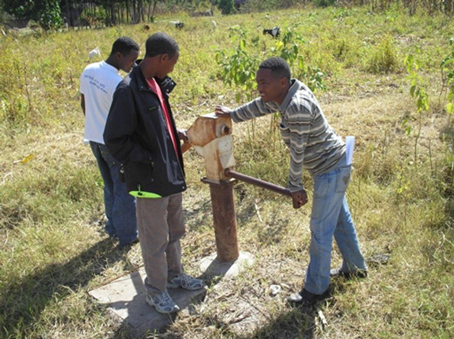
The missing element that frequently could have prevented failure is the establishment of a local operation and maintenance (O&M) system at community or village level that could find ways to recover the O&M costs.
The OWNP aims to address this and other problems for this sub-component through the following main activities:
- Studies on different issues of water supply, e.g. feasibility studies, situational analysis.
- Development and construction of new point sources and small piped schemes with distribution systems, including multi-village schemes. (Point sources of water supply include hand-dug wells and protected springs which are accessed at the source. Small piped schemes are water systems with a piped extension from the source for distribution. Users do not access water at the source but far away at the distribution point. Multi-village schemes extend from a single common source to many villages located around it, with separate distribution points for each village.)
- Rehabilitation of existing point sources.
- Expanding small piped schemes.
The first of these activities focuses on studies such as feasibility studies and situational analysis. You may be wondering how studies can contribute to the success of the rural water supply sub-component of the OWNP. A feasibility study is conducted before the construction of the water supply scheme to discover if the construction is technically possible and can be achieved at reasonable cost. It would also evaluate whether or not the amount of water from the intended scheme is sufficient for the community. Situational analysis means a critical review of all aspects of a current situation in order to inform planning and decision making. For WASH schemes this involves assessing population numbers and distribution, socio-economic status, local geography, existing WASH services and usage, and so on. Undertaking studies of this type and applying study results appropriately can help to define programmes more precisely in order to make them more effective in terms of achieving targets, and efficient in the proper use of resources (money, personnel and time).
The rural water supply sub-component of the OWNP includes clearly defined implementation modalities. Modality means the way or ‘mode’ in which something is done or, in other words, an approach or procedures followed to carry out a certain task. The implementation modalities are:
- Woreda-managed project (WMP) modality
- Community-managed project (CMP) modality
- NGO-managed modality
- Self-supply modality
- Multi-village water supply schemes.
Each of these modalities is described in more detail in Study Session 10. For now, we will simply provide brief introductions.
Woreda-managed project modality
For this mode of implementation, the Woreda WASH Team (WWT) plays the leading role in all aspects of project management. The WWT carries out its leadership role in close collaboration with kebele administration and community WASH Committees (WASHCOs). (Woreda WASH Teams and WASHCOs were established by the 2006 WASH Memorandum of Understanding (MoU). You will learn more about these and other aspects of the organisational structure for WASH in the next study session.)
Community-managed project modality
This implementation modality relies on community members, particularly WASHCOs. The distinguishing feature of this modality is that it enables communities to fully own their water supply projects, which consequently ensures sustained service. This modality mainly focuses on the development of low-cost and small-scale schemes such as hand-dug wells and springs.
Why would ownership of the water supply, such as a well and hand pump, be empowering for a community?
If the community owns the well and pump they will take pride in looking after it and ensuring it is well maintained. The collaboration required in managing the pump and the collective decision making and actions of the WASHCO is likely to strengthen relationships between community members and encourage collaboration on other matters.
NGO-managed modality
Non-governmental organisations (NGOs) are important actors in the WASH sector. (You will find more details about their role as stakeholders in Study Session 9.) Many NGOs pioneer new innovations in terms of WASH technologies and implementation approaches. To give some examples of NGO modality, Plan International is known for using the community-led total sanitation and hygiene (CLTSH) technique, JICA and WaterAid for promoting rope pumps (see Figure 6.2) and CRS-Ethiopia for the innovative latrine technology called the ArborLoo (see Figure 6.3).
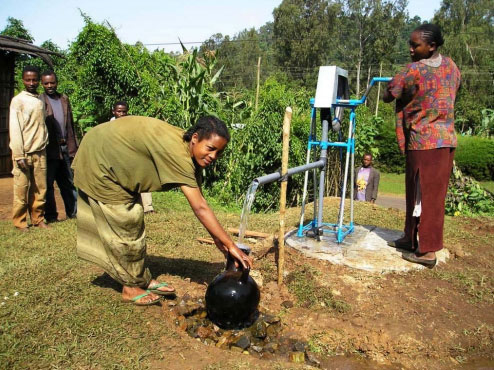
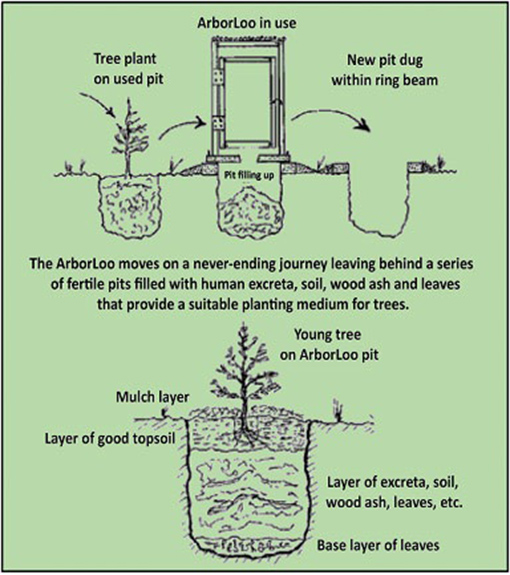
Self-supply modality
Self-supply means the construction and use of small-scale water schemes at household level, such as hand-dug wells, and is particularly appropriate in rural areas.
Multi-village water supply schemes
Some water schemes may have the potential to be used by a cluster of villages. If a thorough feasibility study confirms that the source is adequate and that the design and construction of a water supply system can address multiple villages sustainably, this modality will be considered.
6.2.2 Rural sanitation and hygiene promotion
Since 2004, the progress made in sanitation and hygiene promotion in rural areas of Ethiopia has been remarkable. For example, between 1990 and 2012 Ethiopia reduced the percentage of the population using open defecation from 92% to 37%, the highest percentage point reduction of any country in the world (JMP, 2014b). This visible progress was attributed to the establishment of a good working environment, such as by developing and applying strategies, manuals and guidelines, and also the strong commitment and collaboration of the Ethiopian government and its partners. 2004 was also marked by the launch of the Health Extension Programme (HEP), which has resulted in more than 38,000 Health Extension Workers (HEWs) deployed to rural kebelesto promote preventive health. The HEP training is structured into 16 packages, of which seven are WASH-related. Along with the HEWs, the Health Development Army (Box 6.1) established by community members has been instrumental in promoting sanitation and hygiene for their respective communities.
Box 6.1 Health Development Army
The Health Development Army (HDA) started in 2010–2011. It is one of the community-level structures established to facilitate efforts to promote primary health activities, including WASH, at grassroots level (Figure 6.4). The HDA are organised groups of families who promote healthy activities and behaviour among other families.
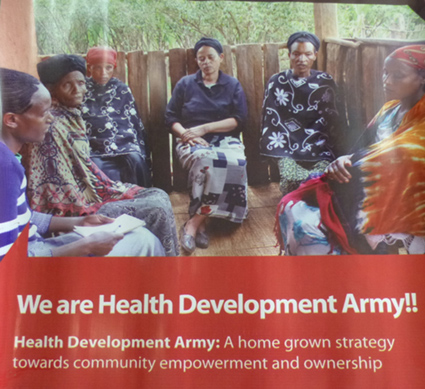
The HDA comprises ‘one-to-five networks’, which each consist of one model family and five other households who live nearby. Model families are early adopters of desirable health practices. They act as role models for other households and encourage them to adopt desired practices and behaviours. Households are selected for model family training based on their involvement in other development work, and on acceptance and credibility within the community.
The one-to-five networks serve as a forum for exchange of concerns, priorities, problems and decisions relating to health. These networks were designed to empower women in particular, and the family in general, in health decision making leading to democratisation of health and to community partnership. The networks are supported by the local HEWs and are responsible for the preparation and completion of plans for collecting health information, conducting weekly meetings to review progress, and submitting monthly reports.
(Adapted from Teklehaimanot and Teklehaimanot, 2013)
6.3 Pastoral WASH
Pastoralism is a way of life in which people who keep livestock such as cattle, sheep, goats and camels move from place to place looking for sufficient water and food for their animals. People whose livelihood is based on these activities are known as pastoralists.
Pastoral areas in Ethiopia cover 61% of the land mass of the country (PFE, n.d.) and support 12–15% of the country’s human population and a large number of livestock. These areas, commonly called ‘rangelands’, are located in the arid and semi-arid lowland parts of the country (Figure 6.5).
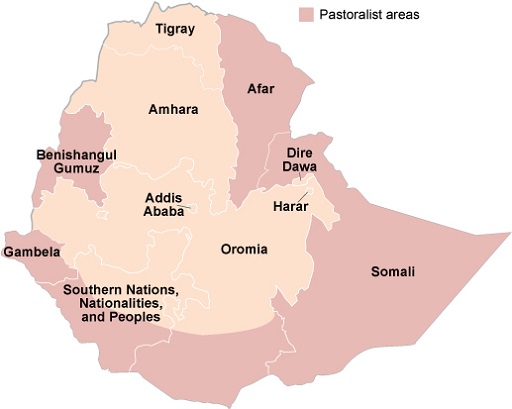
In general, access to safe water supply and sanitation facilities in pastoralist areas is lower than that of non-pastoralist areas. In most cases, water sources, such as traditional water wells do not produce sufficient water to satisfy human and livestock requirements. As shown in Figure 6.6, the water level is low and the craftsmanship of the well is poor, making drawing water very difficult and laborious.
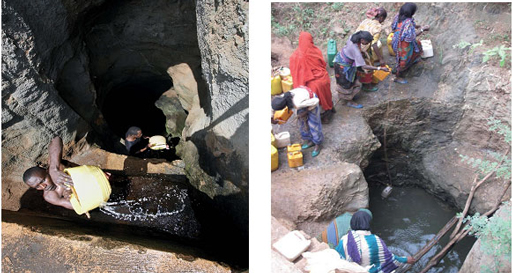
Why do you think access to water and sanitation in pastoralist areas is so low?
The people move around with their animals so they do not have a fixed location where they live. Safe water supply and sanitation services require fixed constructions like pumps and latrines, therefore it is difficult to provide these for people on the move.
6.4 Urban WASH
Ethiopia is predominantly a rural country with only 18% of the total population currently residing in urban areas. However, recent trends in urban population growth show how this figure is rapidly changing. It is estimated that the urban population will be 30% of the total by the year 2040 (Figure 6.7).
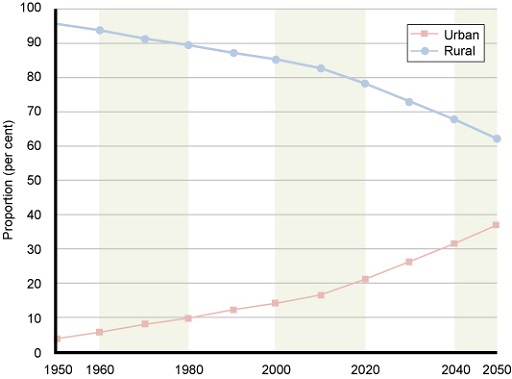
The urban water supply component of the OWNP provides selected towns with technical assistance through grants and/or loans to improve their water supply service. Towns are classified according to their water supply provision and management status into three categories, as shown in Table 6.1. All three categories are supported by the urban WASH programme through various levels of interventions based on need assessment (FDRE, 2013c). Support may also include liquid waste management linked to sanitation and hygiene promotion.
| Category | Description |
|---|---|
| 1 | Towns/cities having utilities managed by a Water Board |
| 2 | Towns/cities having utilities but not managed by a Water Board |
| 3 | Small towns with water supply systems managed by WASHCOs or towns without a water supply system at all |
Town Water Boards are committees of representatives from all the WASH sector offices (water, health, education) and from communities and other user groups.
The Board is responsible for monitoring and evaluation of the overall performance of the water supply system. The board is directly accountable to the town (or woreda or city) council or administration. Utilities or water utilities are organisations entrusted with the task of providing water supply service to their respective towns in a timely, cost- and quality-conscious manner. They may also be called Town Water Supply Enterprises, or Town Water Supply and Sewerage Enterprises in locations where there is, or will be, a sewer network. Water utilities are accountable to the Town Water Board.
An important difference between rural and urban is that full cost recovery is applied for urban water supply. Full cost recovery means that the water supply service is able to recover the cost of operation and maintenance of the water supply system as well as the cost of investment, Investment costs include, but are not limited to, costs for water source development, treatment, installation of distribution systems, electro-mechanical materials, installation of pumping stations, construction of office and auxiliary buildings etc.
6.5 Institutional WASH
Public institutions can include schools, colleges, health facilities, prisons, administration offices and other public buildings. In the OWNP, institutional WASH deals only with schools and health facilities because these have priority, based on the comparative benefits from WASH interventions. In Study Session 1, you read of the importance of WASH in schools.
What are the main benefits of good WASH facilities in schools?
They will improve children’s health which will result in better school attendance and consequently, better educational achievement. Schools with child-friendly services and separate facilities for boys and girls, will make school more appealing to children, especially girls, and also parents.
Improving school WASH services also has the potential to use students as change agents. (A change agent, or agent for change, is someone or something that helps to make changes happen.) The students will take their knowledge and experience home to their own families and reach other families, which will facilitate the community-level WASH promotion efforts at large.
Focusing on healthcare facilities also brings significant benefits. Reliable WASH services at health posts, centres and hospitals will prevent, or at least minimise, infections and ensure the recovery of patients. They provide a good model for people visiting the health facility that will help convince them to have WASH facilities at their home and also to use and maintain the facilities properly.
In schools and health facilities, it is always necessary to make sure that all the three sub-components of WASH – water supply, latrines and handwashing facilities, are available all together, as illustrated in Figure 6.8.
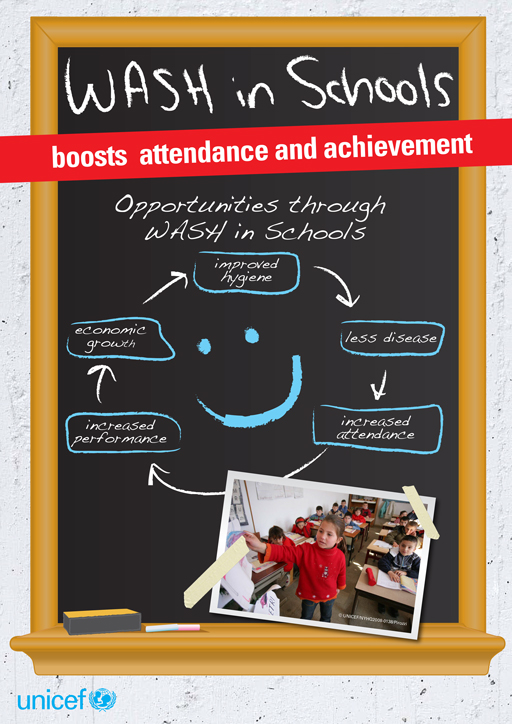
According to the National WASH Inventory (introduced in Study Session 3), safe water supply for primary schools stands at 31%, while sanitation coverage is 33% in an estimated 27,000 primary schools across Ethiopia. In the country’s 3,200 health facilities, only 32% have safe water. Fortunately however, the commitment of the Ethiopian government to improve WASH services in schools and healthcare facilities is encouraging.
6.6 Programme management and capacity building
The fourth component of the OWNP covers programme management and capacity building. These are cross-cutting interventions across all the programme components described earlier. Programme management deals with all the processes involved in putting a programme into effect. It encompasses planning, implementation, monitoring and evaluation activities in terms of both finance and physical undertakings. Capacity building is similar to capacity development, which you read about in the previous study session. It is the process through which individuals, organisations and societies obtain, strengthen and maintain the capabilities to set and achieve their own development objectives over time.
This component includes support to improve the skills and capacity of WASH organisations and implementing parties at all levels. This is done through the provision of training, equipment, and tools, and, where required, software. Added to this, Technical and Vocational Education Training Colleges and Health Science Colleges will be supported to provide relevant training to WASH technicians. It is possible that you may be studying this Module as part of such a training programme.
Summary of Study Session 6
In Study Session 6, you have learned that:
- The OWNP has four major components: rural and pastoral WASH, urban WASH, institutional WASH and programme management and capacity building. There are sub-components covering water supply and sanitation separately.
- Rural water supply has five implementation modalities: woreda-managed projects, community-managed projects, NGO-managed, self-supply and multi-village schemes. In rural areas there is a history of failed water supply schemes due to lack of community participation.
- Rural sanitation and hygiene promotion is mainly undertaken by Health Extension Workers and the Health Development Army.
- Pastoral areas have particular difficulties accessing water and sanitation and need a different approach.
- Urban water supply is the responsibility of Town Water Boards and water utilities.
- Full cost recovery is expected to be applied for urban water supply whereas rural schemes are only expected to recover O&M costs.
- Institutional WASH in the OWNP includes schools and healthcare facilities. Good WASH services in these institutions are especially important to prevent the spread of waterborne diseases and promote good hygiene behaviour among children and the wider community.
- The programme management and capacity building component is a cross-cutting intervention that aims to strengthen and facilitate implementation of the WASH plans that are disaggregated into the first three components.
Self-Assessment Questions (SAQs) for Study Session 6
Now that you have completed this study session, you can assess how well you have achieved its Learning Outcomes by answering these questions.
SAQ 6.1 (tests Learning Outcome 6.1)
Match the following words to their correct definitions.
Using the following two lists, match each numbered item with the correct letter.
multi-village schemes
situational analysis
O&M costs
modality
full cost recovery
feasibility study
a.critical review to find out about a situation to inform planning and decision making
b.finding out if a project is technically possible and achievable at reasonable cost
c.water supply sources extended from a single common source to many villages located within same radius, with separate distribution points for each village
d.running costs of a project that will continue over time
e.to recover the cost of operation and maintenance as well as the cost of investments
f.a way of doing something or approaching a task
- 1 = c
- 2 = a
- 3 = d
- 4 = f
- 5 = e
- 6 = b
SAQ 6.2 (tests Learning Outcome 6.2)
Name the four programme components of the OWNP, as described below:
- a.………………, in which most beneficiaries depend on agriculture and cattle husbandry as their livelihoods.
- b.………………, in which beneficiaries reside in areas where there are relatively better socio-economic infrastructure and service provision.
- c.………………, in which schools and healthcare facilities are particularly focused.
- d.………………, which is a cross-cutting intervention across the other three programme components.
Answer
- a.Rural and pastoral WASH
- b.Urban WASH
- c.Institutional WASH
- d.Programme management and capacity building
SAQ 6.3 (tests Learning Outcome 6.3)
Consider the component you identified in SAQ 6.2 part (c). Why do schools and healthcare facilities receive particular attention?
Answer
Focusing on schools aims to improve the health of school children and reduce absenteeism caused by sickness resulting from lack of WASH services in the school. As a result of better school WASH services, educational performance is improved. In addition, proper WASH services and related education in the school is a means to spread WASH-related messages to families and the wider community using students as ‘change agents’.
Similarly, the availability of WASH services in healthcare facilities significantly improves the quality of medical services and prevents infection and helps the healing process in patients. Moreover, the existence of proper WASH services in health facilities can be a good model for people visiting the health facility to adapt at home if they can.
SAQ 6.4 (tests Learning Outcome 6.3)
Consider the component you identified in SAQ 6.2 part (a). What are the five implementation modalities for the water supply element of this component?
Answer
The implementation modalities for the rural water supply component are:
- Woreda-managed project (WMP) modality
- Community-managed project (CMP) modality
- NGO-managed modality
- Self-supply modality
- Multi-village water supply schemes.
SAQ 6.5 (test Learning Outcome 6.3)
Consider the component you identified in SAQ 6.2 part (b). What are the three categories of town within this component?
Answer
- Towns/cities having utilities managed by a Water Board
- Towns/cities having utilities but not managed by a Water Board
- Small towns with water supply systems managed by WASHCOs or towns without a water supply system at all.
SAQ 6.6 (tests Learning Outcome 6.4)
Programme management and capacity building is one of the four components of OWNP. How would you describe its role in the programme implementation process?
Answer
Programme management and capacity building are cross-cutting interventions that are applied to boost the implementation of the OWNP and consequently maximise the results in terms of quantity and quality. The actual activities in this component include, but are not limited to, supporting WASH organisations and implementing parties at all levels to help them to improve their skills and capacities. This can be achieved through the provision of training, equipment, and tools, and, where required, software used for various WASH undertakings.